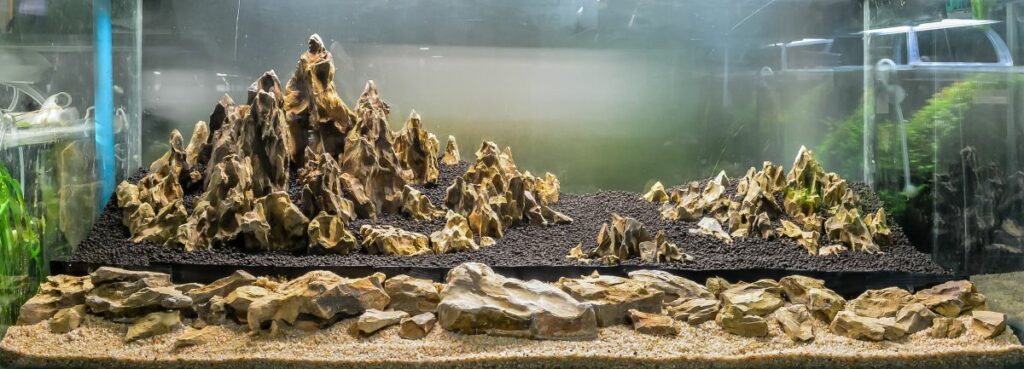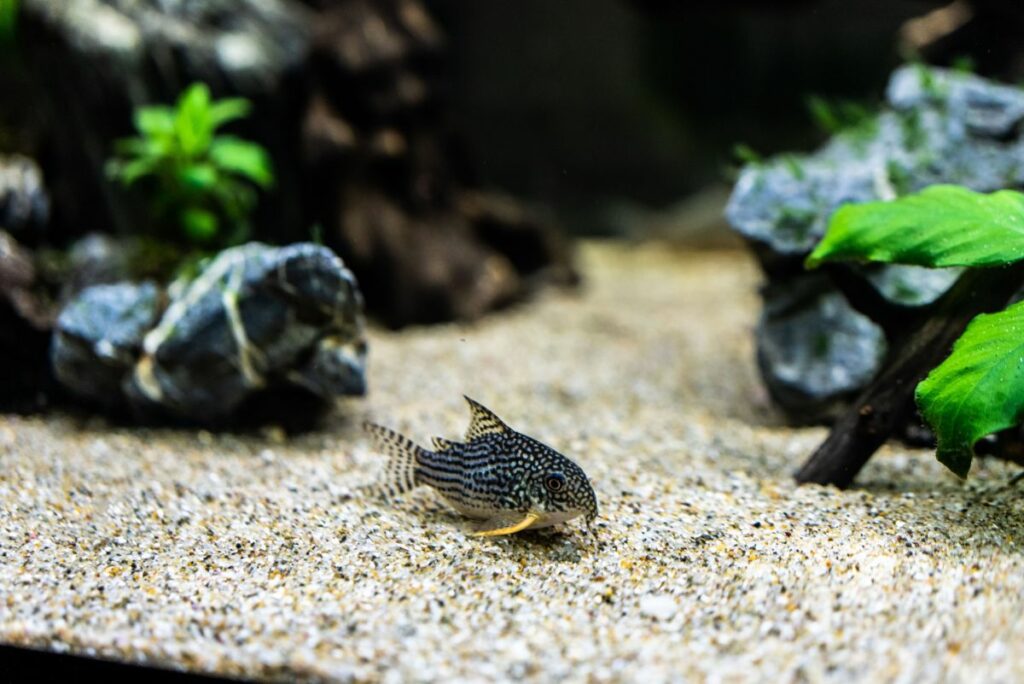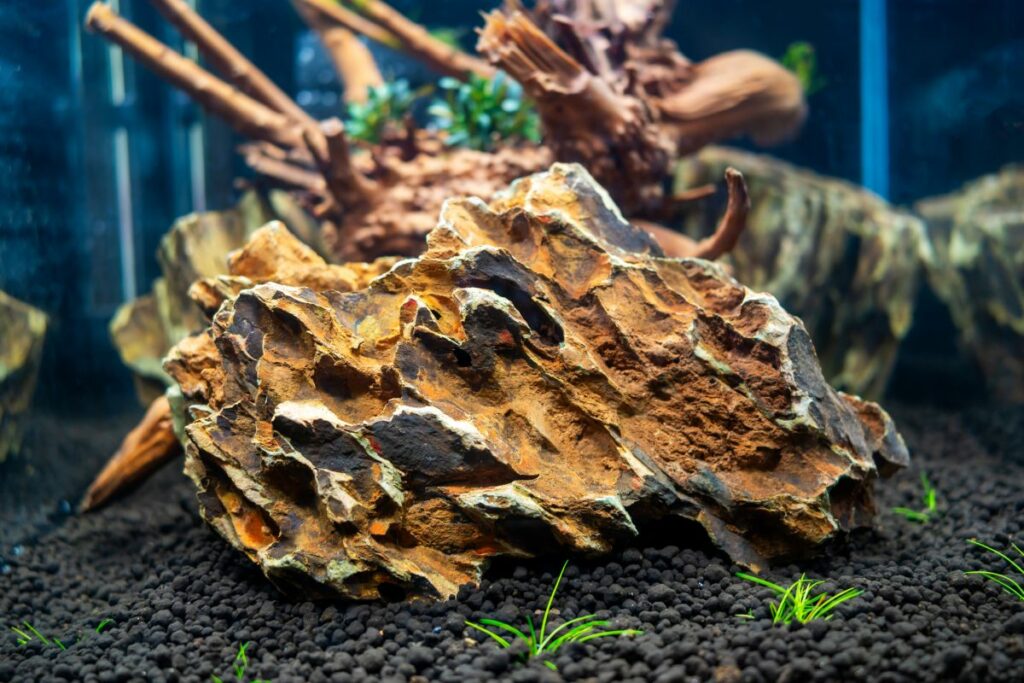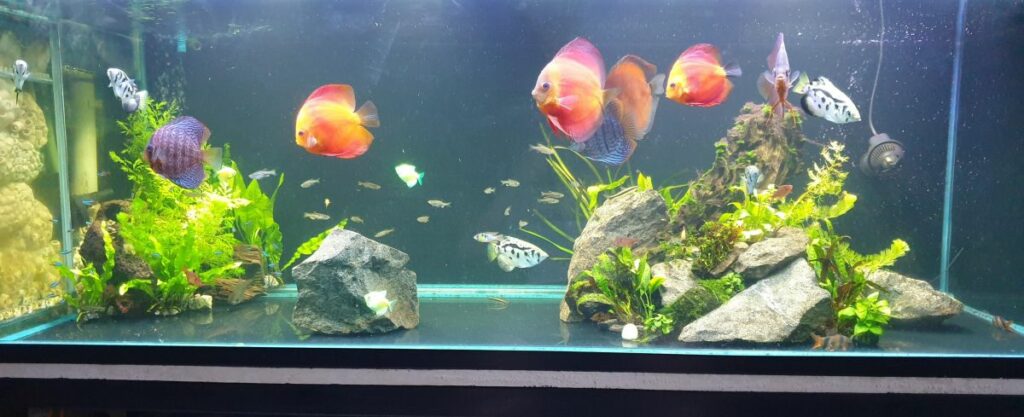Choosing the right substrate is one of the most important steps to setting up a new aquarium. Most aquarists choose a fish tank substrate that looks nice. But aquatic substrates offer major benefits beyond good looks. These include additional filtration, a place for plants to live, and habitat for your fish.

What is Substrate in a Fish Tank?
The substrate in a fish tank is the layer of material that coats the bottom of an aquarium. Substrates are made of fractured organic matter, inorganic materials, or a blend of the two.
The substrate is a critical part of the overall aesthetic because it takes up a lot of visual real estate. Substrate color will affect the colors of your fish and how well your plants stand out in an aquascape.
Aquarium substrates are also a critical component of the biological filtration system of your tank. Nitrifying bacteria live here as well as in your filter. They consume the ammonia your fish create, detoxifying it in a series of steps into less toxic nitrate.
The substrate in aquarium also protects the bottom glass from heavy decorations. Rocks, driftwood, and other items should never be pressed against the glass. They could scratch or even shatter your tank from below.
Types of Aquarium Substrate
There are four main types of aquarium substrate for hobbyists to choose from:
Aquarium Gravel
Aquarium gravel for fish tanks is by far the most popular choice. Gravel is inexpensive and easy to clean. It comes in an endless variety of sizes and colors. And it is compatible with a wide range of fish and plants.

Gravel grains range between 2mm to 6mm in diameter. They are formed from crushed bits of rock. Igneous and metamorphic rocks like granite, gneiss or quartzite are the most common components.
These are good rocks for fish tanks because they don’t contain high levels of dissolved minerals that would raise the pH of your tank. Fish tank gravel also looks good when mixed with sand or aquarium soil.
Marine aquariums often use crushed aragonite (coral skeletons) instead. Saltwater fish tank gravel is pale to bright white. It contains calcium and carbonate and will raise your tank’s pH and water hardness.
Gravel has a moderate to high surface area thanks to its grain size. Beneficial bacteria are able to find places to grow, complementing the ammonia-detoxifying activity of your filter.
One downside of using gravel is that it’s inert. If you want to grow live plants you have to enrich it using fertilizer root tablets. Many plants also get their nutrition from the water column so liquid dosing is often effective.
Aquarium gravel is also good at collecting mulm over time, a brown film of microbial life and organic matter. Any healthy, mature aquarium substrate has mulm in it. The large pore spaces between gravel grains are sized just right for gathering it.
Mulm is great for plants but it doesn’t look pretty when it starts to become visible against the aquarium glass. Deep cleanings using a siphon hose are important if you want a mulm-free substrate.
Aquarium Sand
Freshwater aquarium sand is the second most popular substrate. Sand creates a different aesthetic from gravel. The fine grains create a silky smooth surface for fish to glide over. Sand is formed from quartz grains, which are inert in water and won’t raise the pH.
One major upside to using sand is that it is soft on the skin of fish that like to dig. Smaller cichlids like electric blue rams and kribensis dig as much as larger species do. Big gravel grains make it difficult for them to engage in natural behavior.
Many bottom dwelling fish have small scales or scaleless skin. Kuhli loaches and dragon gobies prefer to burrow into soft sand, silt, and mud. Cory catfish have armored scales – but their whiskers are delicate.
If these fish species try to dive or root around to aquarium gravel the large, sharp edged grains will cause injuries. With aquarium sand your bottom dwellers are able to burrow without pain.
Sand has a high surface area thanks to the small grain size. It provides an excellent place for beneficial bacteria to colonize.
You can also use sand in planted aquariums. The grains are much more compacted compared to gravel. Plants with fine roots like carpeting plants have an easier time growing in sand versus gravel.
The main downside to using sand substrate is that it looks dirty faster. Debris like fish poop and leftover food will fall between gravel grains and remain hidden for a long time. In a fish tank with sand these bits sit right on top of the substrate. If you perform small, frequent water changes it’s easy to keep sand looking tidy, however.
Aquarium Soil
Aquarium soil is the choice I use in most of my freshwater tanks because I grow live plants. Aqua soils come in many different varieties and most are colored to match a natural aesthetic (black, red, brown, or mixed colors).

An aquarium soil substrate mixes the benefits of gravel and sand but some of the drawbacks as well. Most come as small soil pellets the size of aquarium gravel. But other brands are made from fractured clay the size of sand grains.
They are enriched with plant nutrients that are slow-released to the roots. Aquarium soil is also loose enough for plants to penetrate, ensuring their grip stays firm even if you have large, clumsy fish.
Fish tank soil is easy on the skin of burrowing fish. And it has a high surface area so beneficial bacteria can colonize it with ease.
Soil substrates also collect nutrients in the water column thanks to their high cation exchange capacity (CEC). Liquid fertilizer doses, phosphates from fish food, and other nutrients get trapped in aquarium soil for plants to use in the future.
Aquarium soil has two main drawbacks, however. The first is that it’s the most expensive type of aquarium substrate. A bag of high quality aquasoil might be 5x the price of the same volume of sand or gravel.
Aquarium soil substrates are also messy. Pre-washing is essential for most brands. And even if you do several rinses the tank could be cloudy for days. Clay based aquasoils like Seachem Flourite are the messiest while baked soil pellets are easier to rinse clean.
Using Potting Soil in Aquarium
Potting soil is becoming commonplace in the aquarium hobby. It’s much less expensive than name brand aqua soils and provides similar benefits. It is also the most difficult aquarium substrate to work with because there are so many options out there.
You have to find an organic potting soil blend that has a few additives but not too many. Many are enriched with fertilizer that your plants will like. But too much fertilizer will cause huge algae issues in an aquarium.
Ammonia is a common fertilizer for potting soil, which is toxic to all aquatic animals. Some brands also have pesticides that will kill your fish.
Potting soils sometimes have large pieces of wood, water retaining gels, mica, and other additives that are at best neutral to fish health. But these bits will float in the water or look ugly if exposed.
Potting soil is also easy to disturb. A fish that likes to dig or swims nearby too fast will release a big burst of soil into the water column. Overall, I do recommend potting soil in aquariums but for advanced level aquascapers only.
Fish Tank Pebbles
Aquarium pebbles are a step up in size from gravel grains. They range in size from 6+mm to a few inches. They are popular choices for betta aquariums and additions to a fish tank with a sand or gravel base.
I don’t use fish tank pebbles because the gaps between each rock are too large. They also offer little surface area for beneficial bacteria to colonize. The grains are too large for plants to root in and fish to dig through.
What is the Easiest Substrate to Clean?
Gravel is the easiest substrate in aquariums to clean. It has the dual benefit of hiding debris between the grains and letting it go when you run a siphon hose through it.
Sand is also easy to clean since debris sits on top for fast collection. But it tends to collect algae and mulm if you don’t do frequent water changes. Deep cleaning sand is difficult with a siphon hose since sand grains are small enough to get sucked out of the aquarium.
What Color Substrate in Aquarium Should I Use?
The color of your aquarium substrate is more of a personal choice. Some aquarists prefer natural colors that resemble a river or lake bed. But the blue, pink, or mixed neon colors found in pet stores and pre-made aquarium kits are a valid choice.
Dark fish tank flooring will encourage your fish to deepen their colors. Light substrates will cause them to wash out. Aquarium fish do this to try and stand out less against the background so predators don’t spot them.
How Much Substrate Per Gallon?
The general formula for aquarium substrate is one pound per gallon of water volume. We want 2 to 3 inches of substrate at the bottom of standard sized fish tanks.
The formula will need adjustment if you have a “tall” or “breeder” style tank, however. Breeder aquariums maximize floor space while a “high” or “tall” aquarium has a small floor.
The one lb per gallon formula is also less accurate for aquarium soil because it weighs less than sand or gravel. Yet it will cover a large area despite being lightweight.
Bare Bottom Fish Tank
One alternative to using substrates for aquariums is to set up a bare bottom fish tank. Here, the glass is laid bare so water and fish come into direct contact with it.

Bare bottom setups are common among monster fish keepers (arowanas, large cichlids, red tail catfish, etc) that want to minimize costs and maintenance time. A 200+ gallon tank is expensive to fill with aquarium substrate. All that sand or gravel also complicates water changes. A bare bottom tank can be swept clean of feces and leftover food in a fraction of the time.
Decorations for a bare bottom tank have to be chosen with care since there is no protective substrate layer against the glass. PVC pipes, clay pots, and pieces of soft driftwood work best since they won’t scratch the bottom glass.
Conclusion
Aquarium substrates come in several varieties, each with significant benefits and drawbacks. These include upfront costs, maintenance difficulty, plant enrichment, and fish health. You also have an endless array of colors and blends to select from. So the best aquarium substrate really is personal choice, based on your needs as a hobbyist.
FAQs
Betta fish will thrive on any aquarium substrate. They visit the bottom to look for leftover food but don’t dig or lay against the substrate. Choose whichever substrate best matches your aesthetic vision.
A planted aquarium should have 2 to 3 inches of substrate depth. Less results in shallow root anchors that are easier to disturb.
A 10 gallon aquarium is a standard sized fish tank. Two 5 lb bags of sand or gravel will be enough to create a 2 to 3 inch layer along the bottom of your fish tank.
Sand takes little effort to prepare. First add it to a bucket. Run clean tap water through it and stir it up using your hands or a tool. Stirring lifts any fine dust that would irritate the gills and mucus membranes of your fish. Pour off the silty water and rinse it a second time. Keep rinsing the sand until the poured off water runs clear. The preparation process is the same for aquarium gravel and aquarium soil.

